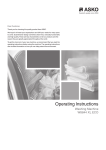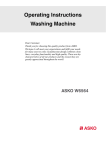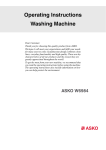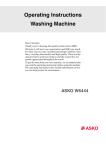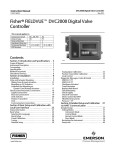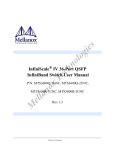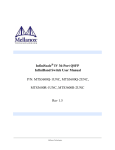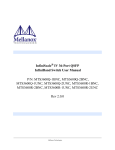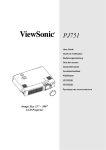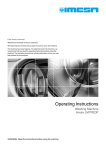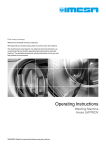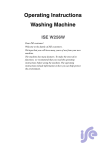Download Asko W8844 XL Operating instructions
Transcript
Dear Customer, Thank you for choosing this quality product from ASKO. We hope it will meet your expectations and fulfil your needs for many years to come. Scandinavian design combines clean lines, everyday functionality and high quality. These are key characteristics of all our products and the reason they are greatly appreciated throughout the world. To get the most out of your new machine, we recommend that you read the operating instructions before using the machine. The operating instructions also include information on how you can help protect the environment. Operating Instructions Washing Machine W8844 XL WARNING: Read the instructions before using the machine. CONTENTS SAFETY INSTRUCTIONS Child safety 3 3 The washer door will not open 14 Installation3 Opening the door in an emergency: 14 Overflow guard function 3 After power failure 14 Transport/winter storage 3 Wet washing still in the machine 14 Packing material 3 Error messages 14 SAFETY INSTRUCTIONS 4 TECHNICAL INFORMATION 15 ADVICE AND TIPS BEFORE WASHING 5 TECHNICAL INFORMATION 16 5 INSTALLATION18 Recycling4 Laundry label symbols Sorting your laundry 5 Clothing5 Coloured cotton 5 Unbleached linen 5 Wool5 Save time and energy 5 High water level 6 Economy and efficiency 6 Detergents6 Dyeing fabrics USING YOUR WASHING MACHINE Add detergent and fabric softener 6 7 7 Program selection 7 Selecting options 9 During the programme 10 SETTINGS11 Cleaning the trap and the drainage pump 12 Cleaning the detergent compartment 12 Cleaning the outside of the machine 12 Cleaning the inside of the machine to avoid unpleasant smells 12 Rinse holes under the agitator 12 If you have hard water 13 Original instruction 2 TROUBLESHOOTING14 Information for test institute 15 Positioning the washing machine 18 Adjusting the feet 18 Connection to water supply 18 Drainage connection 18 Electrical installation 18 Before contacting the service division 20 BEFORE CONTACTING THE SERVICE DIVISION20 PROGRAMME CHART 21 QUICK GUIDE 23 SAFETY INSTRUCTIONS GENERAL • Read the operating instructions and keep them in a safe place. • Installation should be carried out by qualified ASKO technicians. • The machine should only be used for washing items as described in these instructions. It is not intended for dry cleaning. Activated child safety catch Inactivated child safety catch • Use only detergent intended for machine washing! • Repairs and maintenance must be carried out by a qualified professional. • Damaged mains cables must only be replaced by a qualified electrician. • The machine is not designed to be used by persons (even children) that are physically or mentally handicapped or lack experience and knowledge. Such persons must receive instruction in how to use the machine or be supervised by a person responsible for their safety. • Children must be watched to ensure they do not play with the machine. • In the enclosed plastic bag you will find a tool for opening the washer door in emergencies. CHILD SAFETY • Always close the door and start the programme immediately once you have added detergent. • The appliance is not intended for use by young children or infirm persons without supervision. • Young children should be supervised to ensure that they do not play with the appliance. • Store detergent and fabric softener out of the reach of children! CAUTION! If this appliance is supplied from a cord extensions set or electrical portable outlet device, the cord extension ser or electrical portable outlet device must be positioned so that it is not subject to splashing or ingress of moisture. Activate Child-safe start (button lock) You can activate the Child-safe start option (button lock) to prevent children from starting the washing machine (see the Settings section). Activate child safety catch (for detergent compartment) On the inside of the detergent compartment is a child safety catch. When the child safety catch is activated you must press the release button to pull out the detergent compartment. INSTALLATION • Carry out the installation and connections in accordance with the separate installation instructions. • Installation of water and electricity, if required, must be carried out by a qualified tradesperson. • Remove any transport protection devices before using the machine. See the separate installation instructions. OVERFLOW GUARD FUNCTION If the water level in the machine rises above normal, the overflow guard function begins to pump water out and shuts off the water intake. If the water level has not dropped within 60 seconds, the programme is terminated. TRANSPORT/WINTER STORAGE If the machine is to be transported or stored in unheated premises where the temperature can fall below freezing, do as follows: • Empty the filter and the drainage pump. See the “Care and cleaning” chapter. • Shut off the water to the washing machine, loosen the supply hose to the intake valve and let the water run out from the valve and hose. • After emptying the pump, a small amount of water may remain in the machine. This does not affect quality or damage the machine. PACKING MATERIAL Sort waste materials in accordance with local guidelines. 3 SAFETY INSTRUCTIONS RECYCLING • This dishwasher is manufactured and labelled for recycling. In order to prevent injuries, the machine must be rendered unusable once the decision has been made to dispose of it. Contact your local authority for information about where and how your machine can be correctly recycled. 4 ADVICE AND TIPS BEFORE WASHING LAUNDRY LABEL SYMBOLS Examples of washing instructions and recommended programmes. Always follow the washing instructions for each garment. Laundry labels Material Cotton, linen, white and light-coloured items. Program Everyday wash 60 °C to 95 °C Cotton, linen, cotton/polyester. Light and dark-coloured garments. Acrylic, viscose, modal, acetate, polyester, polyamide and elastane. Light and dark-coloured garments. Quick 60 °C Wool, silk and other very delicate garments Wool/hand wash 30 °C to 40 °C Easy Care 40 °C or Here are some tips that may help you before washing. SORTING YOUR LAUNDRY Sort items according to: • how soiled they are • colour • material CLOTHING 1 Do up zips and close Velcro straps so that they don’t harm fabrics. 2 New coloured items may contain excess dye and should therefore be washed separately the first few times. 3 Turn delicate items inside out. This reduces the risk of burling and fading. 4 Empty pockets and wash them inside out if possible. COLOURED COTTON Coloured cotton garments labelled with washing instruction 60 °C must be washed at 60 °C initially to remove any excess dye. Failure to observe this advice could lead to the colour running. Use detergent without bleach to preserve the colour of the fabric. UNBLEACHED LINEN Unbleached linen fabrics should be washed at 60 °C, using detergent without bleach or optical brighteners. Heavily soiled linen can be washed at higher temperatures, but not too often as the heat may destroy the sheen and strength of the linen. WOOL These fabrics are labelled for either machine wash or for hand wash. The machine’s Wool/hand wash programme is at least as gentle as washing by hand. Wool is especially sensitive to processes such as washing. If you do not wish to spin dry, you can squeeze out the water using terry towels. In this case select No spin. However, most garments can withstand a short spin. Choose a short spin by selecting a spin speed of 800 rpm or less. RAYON FIBRES AND SYNTHETIC FIBRES LAUNDRY LABELS Look at the item’s laundry label. The table below shows suitable wash programmes for different materials and wash loads. Using modern washing machines and detergents, for example compact detergents, you can usually wash at lower temperatures. It is a good idea to use trial and error to find out what produces the best results. Materials made of rayon fibres, such as viscose, and some synthetic fibres are very delicate and require much space so as not to crease. Only half fill the drum when washing and choose a spin speed of 800 rpm or lower. NOTE! Viscose and acetates are fragile when wet. SAVE TIME AND ENERGY Use the Everyday wash program to save time and energy. This program has a shorter main wash than Standard cotton, but is often sufficient for lightly soiled washing. 5 ADVICE AND TIPS BEFORE WASHING HIGH WATER LEVEL If you want more water for the main wash and rinses, you can use the High water level option. High water level is used automatically in the Wool/hand wash programme. ECONOMY AND EFFICIENCY You can save a lot of energy by not using higher temperature programs than necessary. • Select Quick if you just need to freshen up shirts or exercise clothes, for example. This will save both water and energy. • If you select a fast spin speed, this reduces energy consumption when drying in a tumble dryer or drying cabinet. • Always wash with a full load when using the Heavy, Everyday wash and Normal programs. • Avoid pre-washing. Modern machines and detergents clean effectively without pre-washing. Pre-washing is only necessary for heavily soiled washing. DETERGENTS Eco-labelled detergents are less harmful to the environment. Detergent overdosing does not give better washing results; it merely causes a greater impact on the environment. Try to use less detergent, and increase only if you are not satisfied with the results. DYEING FABRICS If you want to dye fabrics in the machine, select the Everyday wash programme with the Super rinse option. Select temperature according to the dye manufacturer’s recommendations. Choose a low spin speed if the fabric to be dyed is a blended material such as polyester/cotton. NOTE! Add the dye directly to the washing drum – not to the detergent compartment. After dyeing, you should run the machine empty using the same program. Use the normal amount of detergent. NOTE! Due to environmental concerns, we discourage the use of strong chemicals. When using agents for bleaching or stain removal, there is a risk of rust (corrosion) and discolouration of the machine. 6 USING YOUR WASHING MACHINE ADD DETERGENT AND FABRIC SOFTENER Wash ball or net If you use a wash ball or net, place it directly in the drum and select a programme without pre-wash. NOTE! 5 1 2 3 4 Detergent overdosing does not give better washing results; it merely causes a greater impact on the environment; can also hinder the wash performance. Try using less detergent, and increase only if you are not satisfied with the results. 6 Fabric softener Pour the fabric softener into the compartment with the symbol . Follow the recommendations on the fabric softener packaging. NOTE! Do not fill above the compartment’s maximum fill level. Otherwise fabric softener will run in too early, and will impair washing results. 1.Pre-wash 2. Main wash with liquid detergent. Use the separator. 3. Main wash with powder detergent. PROGRAM SELECTION You select a programme by turning the programme selector. The selected programme is shown in the display. Now use the option buttons to select any options. See chapter Selecting Options. Do not use the separator. 4. Fabric softener 5. Release button 6. Child safety catch The quantity of detergent needed depends, amongst other things, on how hard the water is. See the detergent pack for details. Phone your local water company to check the water hardness in your area. The detergent packaging will have recommendations for how much detergent you should use. The machine holds 10 kg of washing. If you only have a small amount of laundry in the machine, you can reduce the amount of detergent used. 1.Auto This program automatically adjusts the length of the main wash and the number of rinses to the amount and type of laundry loaded in the machine. Powder detergent Pour the powder into the compartment for the main wash, and pre-wash as well if desired. Do not use the separator in the main detergent compartment. Liquid detergent Use the separator in the main detergent compartment. Pour the liquid detergent into the front section of the detergent compartment. (For thick detergent, we always recommend using a detergent ball.) 7 USING YOUR WASHING MACHINE 2.Time program This program adjusts itself to the specified time frame or finish time. When using this program, it is however important to select a temperature and time suited to how soiled the laundry is. The spin speed can be selected freely. Specify the desired programme time by pressing + or - on the Time button. The symbol for the programme lights beside the selected time. You can choose a programme time between 30 minutes and 3 hours. If you choose a 30-minute programme time the maximum wash temperature will be 30 °C 3. Heavy Programme for heavily soiled laundry, with dirt that needs to be fully dissolved before the main wash. A pre-wash is used to do this. The machine adapts the programme time and water consumption to the load size. 4. Normal Program for normal to heavily soiled laundry, whites and colours. You can select the temperature freely, so follow the washing instructions for each garment. 60 °C is a good temperature for heavily soiled cotton garments, as well as for garments worn next to the skin. Select 40 °C if the laundry is less soiled. The spin speed can be selected freely. The machine adapts the program time and water consumption to the load size. 5. Everyday wash A standard programme for lightly to moderately soiled laundry. The temperature can be selected freely, so follow the washing instructions for each garment. Garments worn next to the skin ought to be washed at 60 °C. Very lightly soiled laundry generally gets clean already at 40 °C. The spin speed can be selected freely. 6. Quick Fast program for laundry that just needs freshening up. The program can be run at any temperature, so follow the washing instructions for each garment. The lower the selected temperature, the shorter the program time. Garments worn next to the skin ought to be washed at 60 °C. The spin speed can be selected freely. 7. Easy Care Programme for synthetic, mixed fibre and easy care cotton. The programme has a High water level and as such is also suitable for cushions, quilted jackets and the like. Read the washing instructions carefully and remember, for example, that fabric softener must not be used with the membranes found in some outer garments. A washing temperature up to 60 °C and a spin speed up to 1200 rpm can be selected. 8. Synthetics Programme for delicate garments made of synthetic fibre, mixed fibre, rayon and easy care cotton. The maximum temperature is 60 °C, but follow the washing instructions for each garment. Many synthetics will become clean at 40 °C. Garments worn next to the skin ought to be washed at 60 °C. The maximum spin speed is 600 rpm. 9. Wool/hand wash A gentle laundry programme for wool, silk, and garments that should be washed by hand. The highest temperature is 30 °C. The programme has a short spin. The maximum spin speed is 600 rpm. 10. Rinse This program performs one cold rinse cycle + spin. Suitable for laundry that just needs to be dampened and for cleaning cloths and mops. 11. Spin Used to just spin the wash. 12. Drain Used when you only want to drain the water from the machine. 8 USING YOUR WASHING MACHINE SELECTING OPTIONS You can select options to adjust the wash programme to suit your own specific requirements. The available options depend on the selected programme. If the option is available for the selected programme, the symbol lights up when you press the button. The machine will remember the options you select for each programme (applies to Super rinse, High water level and Super wash). You can still change the selected options the next time you select the same programme. Temperature • Select the temperature by pressing the -/+ buttons until the desired temperature is displayed. • You can select temperatures between cold (-) and 90 °C. By selecting cold, the wash temperature will be the same as the temperature of the water entering the machine. For Wool/hand wash it is not possible to select a temperature above 40 °C, when selecting Time program, Synthetics and Easy Care the maximum temperature is 60 °C. Spin • Select the spin speed by pressing the -/+ buttons until the desired spin speed is displayed. • You can select speeds between 400 and 1400 rpm, (no spin) or No D(no drain). The maximum spin speed varies according to the program selected. The speed is shown in the display. • , means that the program does not include a spin cycle and ends by draining. • No D, No drain means that the program does not include a spin cycle and ends with the water from the final rinse still in the machine. The washing will remain covered by the water from the final rinse, stopping it from getting creased. If you have selected “No drain”, once the program has ended you must select the Spin or Drain program to drain the water from the machine before you open the washer door. Delayed start When you select Delayed start the machine will start 1-24 hours after you press the Start button. This option cannot be used with Time program. • Select Delayed start by pressing the + button under the time display. Delayed Start is shown for three seconds. • By pressing the -/+ buttons under the time display you can delay the start in whole hours up to a maximum of 24 hours. The symbol for Delayed start lights beside the number of hours. • Press Start, and the machine counts down 1 hour at a time and starts after the selected delay. If you change your mind and want to cancel Delayed start, you must press and hold the Stop button for three seconds. NOTE! Remember to press the Start button to start the program.. NOTE! Make sure the detergent compartment is completely dry before you add detergent, otherwise there is a risk that the detergent will clump before the machine starts. Super rinse Use the Super rinse option if you want to increase the number of rinses. The maximum number of rinses is seven, and the number of rinses varies depending on the selected programme. Recommended for persons with extremely sensitive skin and/or in areas with very soft water. • Select Super rinse by pressing the button under the symbol. • The symbol above the button lights when this option is activated. 9 USING YOUR WASHING MACHINE High water level Use High water level if a garment’s laundry label shows this symbol. High water level means that additional water is used during the main wash and rinse cycles. • Select High water level by pressing the button under the symbol. • The symbol above the button lights when this option is activated. NOTE! The machine takes in the additional water for the High water level about 15 minutes after the main wash has started. Anti crease Anti crease means that the drum will rotate for three seconds per minute for two hours once the wash programme has finished. This function prevents the clothes from lying in the same position and getting creased. • Select Anti crease by pressing the button under the symbol. • The symbol above the button lights when this option is activated. Super wash Super wash can be selected to better dissolve difficult stains and heavy soiling on clothing. This options adds a cold pre-wash and the the wash time in cold water is extended by approximately six minutes. The main wash time is also extended. • Select Super wash by pressing the button under the symbol. • The symbol above the button lights when this option is activated. Pre-soak Super wash can be selected to better dissolve difficult stains and heavy soiling on clothing. This option adds a cold pre-wash and the wash time in cold water is extended by approximately six minutes. The main wash time is also extended. If the washing is stained, such as with blood, we recommend Pre-soak. The washing will soak in cold water for two hours before the wash programme starts. • Select Pre-soak by pressing the button under the symbol. • The symbol above the button lights when this option is activated. 10 DURING THE PROGRAMME Time remaining The time remaining is shown in hours and minutes. The time remaining is updated three times during the programme. The first update takes place after about 15 minutes. Once a programme is selected, the estimated programme time is displayed. This may differ depending on the temperature of the water entering the machine and the size of the load. If the programme time is longer than the previous wash with the same programme, “0:01” will be displayed until the programme finishes. This is normal! The next time you use the programme under similar conditions, the estimated programme time will be more accurate. Stopping or changing a program You can stop a programme by pressing the Stop button for three seconds. ”Stop” appears in the display. To restart the machine, select a new programme, add any extra detergent needed and press the Start button. NOTE! Do not open the detergent compartment while the machine is running. SETTINGS HOW TO CHOOSE THE SETTINGS: Extra rinses 2 Press and hold the Stop button and then press the main power switch. Then press the Stop button 5 times within 10 seconds. Choose “Rinses On” for five rinses or “Rinses Off” for three rinses. 1 Turn off the machine using the main power switch. 3 Select the setting you want to change by turning the program selector. Upon delivery, your washing machine is set to use three rinses in the Standard cotton andEveryday wash. 4 Press the Stop once. MAKING A SELECTION: Turn the programme selector until the desired selection is shown in the display SAVING A SELECTION: 1 Press Stop to save the selection and return to the settings menu. 2 Press Start to go to the program menu. Options: Press Start to save the selection and return directly to the programme menu, if you do not want to make anymore settings. YOU CAN CHANGE THE FOLLOWING SETTINGS: Child-safe You can activate the Child-safe start option to prevent children from starting the machine. Select “Child-safe On” or “Child-safe Off”. Deactivate the Child-safe option temporarily for three minutes by simultaneously pressing the buttons as illustrated: Language Choose from: US English, AU English, Svenska, Dansk, Norsk, Suomi, Français, Deutsch, Italiano, Espanol, Русский, Ned erlands, EU English. Temperature Choose between: °C and °F. 11 CARE AND CLEANING CLEANING THE TRAP AND THE DRAINAGE PUMP The washing machine has a trap where smaller objects such as coins and hairpins can collect. To clean the trap and the drainage pump, do as follows: CLEANING THE DETERGENT COMPARTMENT Pull out the detergent compartment using the release button. 1 Make sure the machine is empty of water and switched off at the mains. 2 Open the 3 Unhook the drainage hose from the connector inside the door and drain the water into a suitable container, such as a shallow bowl. Rinse the compartment and scrub it clean. The cover in the fabric softener compartment can be removed. NOTE! Do not run the detergent compartment through a dishwasher! 4 Turn the cover anti-clockwise to open the pump. Remove the cover. CLEANING THE OUTSIDE OF THE MACHINE Clean the outside of the machine and the program panel with a mild cleaner. Do not use any solvents, as these can damage the machine. NOTE! Do not hose down the machine with water! 5 Remove any items and so forth from the pump housing and the cover. Also check that the pump blades right at the back rotate. 6 Screw on the cover, replace the drainage hose on the hatch pin and close the hatch. 12 CLEANING THE INSIDE OF THE MACHINE TO AVOID UNPLEASANT SMELLS Run a programme at 90 °C or 95 °C (depending on the model) with a small amount of detergent once a month to avoid problems with odours. It is not necessary to put any washing in the machine. RINSE HOLES UNDER THE AGITATOR If you suspect that objects such as nails or paper clips may have fallen into the wash drum, you should check the space under the agitator. Such objects can rust and leave marks on clothing. Nails and other sharp objects can cause holes in fabrics. CARE AND CLEANING Do as follows: 1 Insert a screwdriver or the like into the hole on the agitator as illustrated and carefully pry to the left. 2 Use your other hand to grasp the agitator and pull it towards you. 3 Lift the agitator. 4 Remove any objects. 5 Place the agitator in the mounting hole with the F-mark towards you. Ensure that all the agitator fasteners are in their holes in the drum. Push it in until it catches. IF YOU HAVE HARD WATER If you live in an area with hard water (high limescale content), a greyish-white coating may form on the washer drum. To remove this, empty a sachet of citric acid, approx. 20 gram , into the washer drum and run any 90 °C programme. Repeat if necessary. 13 TROUBLESHOOTING THE WASHER DOOR WILL NOT OPEN • Check that the main power switch is on. ERROR MESSAGES • Has the power supply been cut off? Check the house fuses (circuit breakers). If an error occurs during the program a message is shown on the display. To exit the message after taking measures, turn the machine off and then back on. OPENING THE DOOR IN AN EMERGENCY: Close the Door WARNING The door may only be opened manually if the electric power is cut and the machine has been drained of water. 1 Run the Drain program to empty the water from the machine. If this does not work the machine must be drained manually. See “Cleaning the trap and the drainage pump” in the “Care and cleaning” chapter. 2 Ensure that the main power switch is turned off and that the plug has been removed from the wall socket. 3 Take the emergency door opening tool and place it in the gap on the right side of the washing machine’s door lock. The tool is attached to the rear of the detergent compartment. Remove the detergent compartment from the machine and remove the emergency door opening tool. 4 Push the tool downwards to open the washing machine door. The error messages that may be shown in the display are: Close the washer door and press Start to start the programme. Over flow fault 1 Shut off the water tap. 2 See “Drainage error”. Water outlet fault Check: • that no objects are stuck in the drainage hose outlet. • that the drainage pump is not blocked by foreign objects. Clean the pump. See the “Care and cleaning” chapter. • that there are no kinks in the drainage hose. After the above, run Drain to empty the machine. If this does not resolve the problem, call the service division. Water inlet fault Check: • that the tap on the water pipe is open. • that the filter in the machine’s water intake is not blocked. Action: 1 Shut off the water tap and unscrew the hose. THE MACHINE WILL NOT START • Is the washing machine door properly closed? Push it firmly. Then press the Start button. • Is there power? Check the fuses and residual current devices (circuit breakers) in the building. 3 Screw the hose back on and turn on the tap. 4 Run the program again to check if the fault is fixed. 5 If this does not resolve the problem, call the service division. • Check that you have not selected Delayed start. To cancel Delayed start, press the Stop button for three seconds. Wash motor fault AFTER POWER FAILURE Unbalance Press the main power switch to resume the current program. WET WASHING STILL IN THE MACHINE A small load can occasionally cause an imbalance Unbalance (see “Unbalance”). Rearrange the load and start the spin programme, or load more washing and restart the washing programme. 14 2 Clean the filter in the inlet valve on the machine. Call the service division! The machine stops the spin cycle if there is too much imbalance. The washing machine restarts the spin cycle and hopefully the washing is better distributed in the drum. This procedure can be repeated up to 10 times. If the machine still fails to find a good balance, the programme jumps to the next step. The error message requires no action. TECHNICAL INFORMATION INFORMATION FOR TEST INSTITUTE Energy labelling Australian standard: AS/NZS 2040.1:2005 Washing program: Normal, 40 °C, 10 kg cotton Connection: Cold water 20 °C Test method for noise measurement: IEC-60704-2-4 Power requirement when machine turned off < 0,3 W Power requirement for Delayed Start < 6,0 W Power requirement when program finished < 3,0 W Detergent, PBIS and Anti-Sudsing Agent (20ml) must be added via the detergent compartment. 15 TECHNICAL INFORMATION Loading procedure for standard test: When loading the machine for testing according to AS/NZS 2040:2005 it shall be loaded according to the table below. Garments are placed on top of each other in layers and the soil swatches should be placed inside the wash drum in the direction shown in the table, seen from above. Top Swatches Swatch placement 38. Pillow case 1 Right 39. Bath towel 37. Pillow case 36. Sheet 35. Undershorts 1 1 Left Front Left 34. T-shirt 1 Rear 32. Tablecloth 1 Right 30. Shirt 1 Front 28. T- Shirt 1 Front 33. Bath towel 31. Bath towel 29. Undershorts 27. Undershorts 26. Pillow case 25. Sheet 24. Wash cloths 1 1 1 1 Rear Center Front Left 23. Bath towel 1 Right 21. T-shirt 1 Rear 22. Shirt 20. Undershorts 19. Undershorts 18. Tablecloth 17. T-shirt 16. Shirt 15. Bath towel 14. Handkerchiefs 1 1 1 1 Center Left Front 1 Right 1 Left 1 Center 13. Sheets 1 Right 11. T-shirt 1 Front 12. Pillow case 10. Undershorts 9. Shirt 8. Bath towel 1 1 1 Rear Center Rear 7. Tabelcloth 1 Left 5. T-shirt 1 Front 3. Pillow case 1 Rear 6. Bath towel 4. Sheets 2. Pillow case 1. Bath towel Total 16 1 1 1 1 30 Right Left Right Illustration of loaded Wash Drum for standard test. 39 38 37 36 TECHNICAL INFORMATION Technical data Width: 595 mm Depth: 700 mm Weight: 82 kg Cylinder volume: 80 l Max. washing capacity: 10 kg Spin speed (rpm): 400-1400 Rated power: See type plate. Heater output: See type plate. Water pressure: 0,1-1 MPa 1-10 kp/cm2 10-100 N/cm2 Wash drum and liquid compartment material: Stainless steel Outer casing material: Powder-coated and hot-galvanized sheet steel or stainless steel. Water connection: 1.5 m pex pipe Drain: 1.7 m polypropylene hose 17 INSTALLATION POSITIONING THE WASHING MACHINE DRAINAGE CONNECTION A. Built-in The lower position (600 mm) is always preferable. Ensure that the drainage hose has no kinks. The washing machine can be installed as a built-in or freestanding unit. Place the machine on a firm surface with easy access to the plug. The washing machine can be installed under a counter top with a working height of 850-900 mm. Leave a 5 mm space around the entire machine, including between the rear edge of the top cover and the wall behind it. B. Freestanding The machine is supplied with a drainage hose attached, which must be connected to a drain. See the examples below. The height must be 600–900 mm above floor level. 600--900 mm The washing machine can be positioned beside or under a tumble dryer. ADJUSTING THE FEET Keep the noise that the machine produces to a minimum by adjusting the feet so that the machine is steady and balanced on the floor. Tighten the lock nuts. Locking nut The machine can also be connected to the drain via a spigot connection. In this case the hose should also be 600-900 mm above the floor. The internal diameter of the hole should be at least 18 mm. • Cut the nipple • Remove burrs from the hole. See the illustration. CONNECTION TO WATER SUPPLY Water connection should be carried out by an appropriately qualified person. Connect the machine using the accompanying supply hose. Water pressure should be 0.1–1MPa (approx. 1–10kp/cm2 ; 10–100N/ cm2). There should be a stopcock on the water pipe. If the pipes are newly installed, it may be wise to flush them through so that any dirt is washed away. Otherwise, dirt can clog the filter in the machine’s water intake and cut off cut off or reduce water flow to the machine. Check for leaks. At least 18 mm ELECTRICAL INSTALLATION Connect the machine by plugging it into an earthed wall socket. The electrical wall socket must be placed outside of the installation area to be easily accessible. CAUTION! If this appliance is supplied from a cord extensions set or electrical portable outlet device, the cord extension ser or electrical portable outlet device must be positioned so that it is not subject to splashing or ingress of moisture. Connection on delivery The machine comes with 1-Phase, 220-230 V, 50 Hz with plug, heat output 2000 W W and fused 10 A. If a residual current device is being used, this should be type A. Use only the supply hose supplied with the machine. Do not re-use old hoses or other loose supply hoses. 18 INSTALLATION NOTE! Repairs and maintenance must be carried out by a qualified professional. Model 1 2 TYPE 3 19 BEFORE CONTACTING THE SERVICE DIVISION BEFORE CONTACTING THE SERVICE DIVISION Before you contact the service division, make sure that you know its model designation (1), type designation (2) and serial number (3). The model designation can be found on the panel. The type designation and serial number can be found on the type plate on the inside of the washer door. NOTE! For repairs and maintenance, original spare parts must be used. 20 PROGRAMME CHART Program Pre- Temp. wash °C Number of Rinses Spin Speed rpm Max. load (kg) Consumption values 1) Water consumption (approx. liter) Energy Programme consumption time (approx. (approx. kWh) hrs and min.) 5 1400 10 117 2,98 2:56 5 1400 10 106 1,51 2:50 3 1400 10 86 1,45 3:40 403),4) 3 1400 10 86 0,92 3:24 5. Every day wash 60 3 1400 10 81 1,61 1:49 6. Quick 40 2 1400 5 36 0,62 0:55 7. Easy Care 403) 2 1200 5 80 0,80 1:45 8. Synthetics 40 3 600 3 43 0,54 1:24 9. Wool / hand wash 30 3 600 3 94 0,67 0:55 1 1400 5 18 0,10 0:21 1400 5 0 0,08 0:16 1. Auto 2) 2. Time program 3. Heavy 4. Normal 10. Rinse 11. Spin 12. Drain 1) X 95 X 60 60 3) 0:01 Consumption data may vary from the given values depending on variations in water pressure,water hardness,water inlet temperature, room temperature, fluctuations in the electricity, type and volume of the laundry and any extra options. 21 YOUR NOTES 22 YOUR NOTES 23 QUICK GUIDE 1. 2. SORT THE WASHING, OPEN THE WASHING MACHINE DOOR AND LOAD THE WASHING Close zips. Look at the item’s laundry label. Sort the washing according to how soiled it is, colour and material. NB! Place underwire bras in a laundry net. TURN ON THE MAIN POWER SWITCH 3. ADD DETERGENT AND FABRIC SOFTENER, AS REQUIRED 4. SELECT A PROGRAMME AND ANY OPTIONS 5. CLOSE THE WASHER DOOR AND PRESS THE START BUTTON The detergent packaging will have recommendations for how much detergent you should use. With only a small amount of washing in the machine, you can reduce the amount of detergent used. You select a programme by turning the programme selector. The selected programme is shown in the display. The available options depend on the selected programme. If the option is available for the selected programme, the symbol lights up when you press the button. The time remaining is shown in hours and minutes. We reserve the right to make changes. www.asko.com WM 80.2 en (12-13)
























